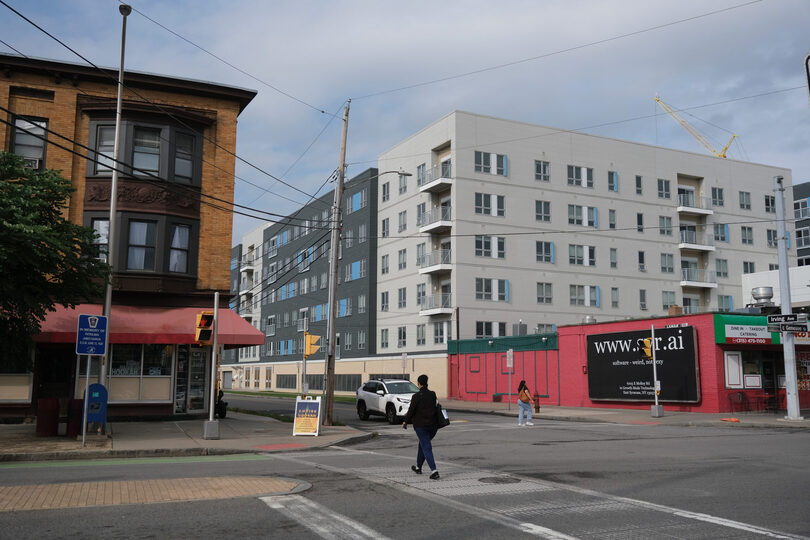Luxury student housing doesn’t deserve subsidies

Maxine Brackbill | Photo Editor
Luxury student apartments erase Syracuse’s unique culture and local residents’ needs, our columnist argues.
To support student journalism and the content you love, become a member of The Daily Orange today.
Growing up, I spent most of my childhood living in the Near Westside and Westcott. Despite my close proximity, I never formed a relationship with Syracuse University. It wasn’t until I was on my way out of high school that I realized how intertwined SU and Syracuse were.
SU enrolled a total of 22,698 undergraduate and graduate students this fall semester. As enrollment continues to increase, more student housing will be required. Building luxury apartments to accommodate a growing student body, however, disregards local residents and the cultural significance of the city’s architecture.
Over the past decade, I watched the surrounding neighborhoods, filled with unique architecture and character, transform with the development of luxury, out-of-place, student housing. The issue lies in the type of structures being built. These modern, cookie-cutter buildings have raised rent in the area immensely, pushing out locals and only serving those who can afford the cost.
At the same time, Syracuse is in desperate need of affordable housing, especially considering that 60 percent of its residents are renters and the city’s average annual income is $22,000. The need will be further exacerbated when families are displaced due to the development of the community grid.
Public housing projects do not have a future in Syracuse, and the displacement of families during the community grid’s development will require affordable housing options. While families living in public housing pay between $715 and $850 for a two-bedroom apartment, a two-bedroom apartment at The 505 costs $1,450 per bedroom a month.
Despite the need for more affordable housing, lawmakers in Syracuse have instead created more and more incentives to build luxury student apartments. Developers behind Theory Syracuse, The Marshall and The 505 on Walnut will save 42 million dollars from property tax breaks and incentives from the city. Large subsidies given to these developers are provided with the intention that they will be revitalizing urban buildings.
But does demolishing a building and replacing it with a pristine new one fall under “revitalization” if the result harms locals?
This year, another developer has bought a property on Genesee Street next to Theory Apartments with the intention to build another luxury student housing spot. The Syracuse Planning Commission has already approved development of “The Coda.”
To make room for the new complex, more buildings are set to be demolished, like the original CNY Ronald McDonald House. Hoover has also requested a 20 million dollar tax break, following the lead of surrounding luxury student apartments.

Fernanda Kligerman | Design Editor
Developers of these apartments can argue that they don’t require potential renters moving in to be students, but the marketing and tenant makeup of these spaces imply otherwise. The subsidies being granted cater to SU students rather than the Syracuse residents who truly need them.
Syracuse has projects and programs with goals to transform the city, and funding should be more directly allocated to these services in order to support locals. The Syracuse Downtown Revitalization Initiative’s goal is to develop programs that turn downtown into a center of economic growth, housing diversity, job creation and more. Promotion of public transportation and creating a more walkable downtown are stated under the DRI’s keys to revitalization as well.
The city should prioritize subsidizing affordable housing options for low-income residents who are being displaced due to the development of luxury student housing. By working together, SU and Syracuse legislators can create a sustainable future that benefits all residents, not just the ones paying tuition.
Syracuse is looking at an 800 million dollar proposal to create mixed income housing to replace public housing such as Pioneer homes. The project is ambitious and these neighborhoods will stay right next door to the university. The only difference will be that highway I-81 will no longer be the shadow that divides the city and SU.
Towering new apartments prioritized for students may be the new divide if there isn’t a priority to connect a stronger relationship between SU and the city. Developers may also see land made available by the construction of the community grid as a way to build more luxury apartments and market towards students rather than the families displaced once public housing is torn down.
Sarhia Rahim is a junior Policy Studies Major. Her Column appears bi-weekly. She can be reached at slrahim@syr.edu.





